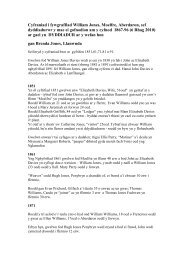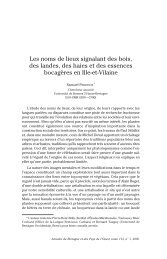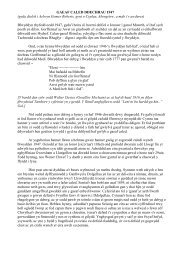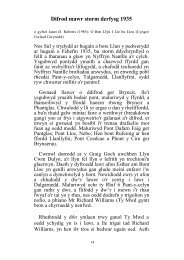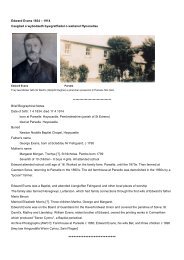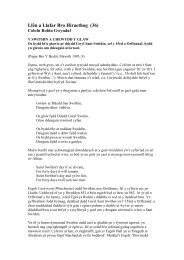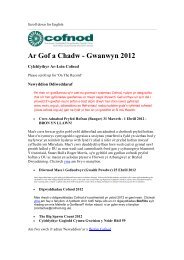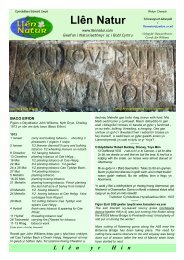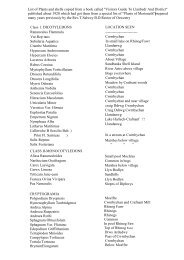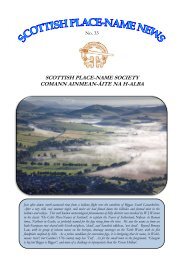lue pool. Llewellyn uses <strong>the</strong> word hoen <strong>in</strong> that sense. " Hoen blodau haf," <strong>the</strong> colour <strong>of</strong> <strong>the</strong> summer flowers.Hoen also implies livel<strong>in</strong>ess, gladness.Perhaps hoen was used to denote <strong>the</strong> lively nature <strong>of</strong> <strong>the</strong> river, <strong>and</strong> ddu, black, to <strong>in</strong>dicate <strong>the</strong> hue <strong>of</strong> itswaters. O<strong>the</strong>rs seem to th<strong>in</strong>k that <strong>the</strong> name is a compound <strong>of</strong> hawn-he<strong>in</strong>i, swift, wild, hasty ; <strong>and</strong> dwy, whichmeans <strong>orig<strong>in</strong></strong>al cause. Dwyf, which signifies 'I am', <strong>the</strong> self-existent, was frequently applied by <strong>the</strong> Druids torivers, such as Dyfrdwy, &c.We ra<strong>the</strong>r th<strong>in</strong>k <strong>the</strong> correct word<strong>in</strong>g is Hawn-ddu, <strong>the</strong> rapid black stream, which is a true description <strong>of</strong> itscourse from its rise on <strong>the</strong> Eppynt mounta<strong>in</strong> to its junction with <strong>the</strong> Usk.Aberllyfni. — Llyfni is a compound <strong>of</strong> llyfn,. smooth; <strong>and</strong> wy, water. The <strong>place</strong> is delightfully situated at <strong>the</strong>junction <strong>of</strong> <strong>the</strong> Llyfni <strong>and</strong> Wye Rivers* English name — Sleekmouth.Aberyscir. — A corruption <strong>of</strong> Aberesgair, from its situation on <strong>the</strong> river Esgair, which discharges itself here<strong>in</strong>to <strong>the</strong> river Usk. Esgair here implies a branch, or tributary. English name — Branchton.Battle. — This small parish, accord<strong>in</strong>g to tradition, received its name from a battle that was fought here, <strong>in</strong>which Bleddyn ab Maenyrch, <strong>the</strong> last <strong>of</strong> <strong>the</strong> Brychan pr<strong>in</strong>ces was killed by Bernard de Newmarch. We, f<strong>in</strong>dseveral <strong>names</strong> <strong>in</strong> <strong>the</strong> vic<strong>in</strong>ity which favour <strong>the</strong> above derivation, such as Heol y Cymry,<strong>the</strong> Welshmen's road;Cwm Gwyry Gad, <strong>the</strong> vale <strong>of</strong> <strong>the</strong> battle men.Beaufort. — The popular Welsh name <strong>of</strong> this <strong>place</strong> is Cendl. from Kendall, <strong>the</strong> name <strong>of</strong> <strong>the</strong> proprietor <strong>of</strong> <strong>the</strong>Ironworks that was once <strong>the</strong> ma<strong>in</strong>stay <strong>of</strong> <strong>the</strong> <strong>place</strong>. The present name was given <strong>in</strong> honour <strong>of</strong> <strong>the</strong> Duke <strong>of</strong>Beaufort.Beulah. — This village takes its name from a chapel <strong>of</strong> that name which belongs to <strong>the</strong> Congregational body.Bronllys. — Some spell it Brynllys, <strong>and</strong> o<strong>the</strong>rs Brwynllys, but <strong>the</strong> former is <strong>the</strong> correct word<strong>in</strong>g. A farmhouse<strong>in</strong> <strong>the</strong> parish is called Bryn y Grots, <strong>the</strong> hill <strong>of</strong> <strong>the</strong> cross. History po<strong>in</strong>ts to <strong>the</strong> probability that wars wereengaged here, from which we may <strong>in</strong>fer that a llys, a court, was held on a certa<strong>in</strong> hill <strong>in</strong> <strong>the</strong> vic<strong>in</strong>ity. The oldcastle is still called Bronllys. English name — Courthill.Brynmawr. — It was anciently called Waun Helygen, willow-tree common, from a meadow <strong>in</strong> <strong>the</strong> <strong>place</strong>which abounded with willow-trees, but when it became an important seat <strong>of</strong> <strong>the</strong> iron <strong>and</strong> coal trades, <strong>the</strong> oldname was changed for <strong>the</strong> new <strong>and</strong> more dignified one <strong>of</strong> Brynmawr, <strong>the</strong> big hill. English name — Big-hill, orHillton.Builth. — This name is a mutation <strong>of</strong> Buallt. Some are <strong>of</strong> op<strong>in</strong>ion that Buallt is <strong>the</strong> Balceum Silurum <strong>of</strong> <strong>the</strong>Romans, but o<strong>the</strong>rs are <strong>in</strong>duced to th<strong>in</strong>k <strong>the</strong> name is a derivative <strong>of</strong> Bual, <strong>the</strong> wild ox or buffalo. Llanfair-pi-Muallt, St. Mary's Church <strong>in</strong> <strong>the</strong> wood <strong>of</strong> <strong>the</strong> wild ox. Historians believe that <strong>the</strong> wild ox ranged unmolested <strong>in</strong><strong>the</strong> forests <strong>of</strong> this district. We <strong>of</strong>fer <strong>the</strong> follow<strong>in</strong>g derivation: Bu, an ox; allt, gallt, a wooded em<strong>in</strong>ence. Englishname — Oxhill.Capel Isaf. — Isaf, lower, is a differentia added to dist<strong>in</strong>guish it from Capel Uchaf. English name —Lowchapel.Capel Uchaf. — The name means <strong>the</strong> higher chapel, <strong>and</strong> it was so called from <strong>the</strong> chapel <strong>of</strong> ease that wasbuilt <strong>in</strong> <strong>the</strong> <strong>place</strong>. English name — Highchapel.Capelyff<strong>in</strong>. — The name signifies boundary chapel, <strong>and</strong> is derived by Mr. Jones (History <strong>of</strong> Brecknock) thus:" In 1708 <strong>the</strong>re was a long dispute <strong>in</strong> <strong>the</strong> ecclesiastical court about this chapel (chapel <strong>of</strong> <strong>the</strong> boundary);Lewis Thomas, clerk, vicar <strong>of</strong> Llanigon, refused to do duty here as <strong>the</strong>re was no salary annexed to <strong>the</strong> cure,whereupon he was cited to <strong>the</strong> bishop's court at <strong>the</strong> promotion <strong>of</strong> some <strong>of</strong> <strong>the</strong> parishioners, <strong>and</strong> <strong>in</strong> <strong>the</strong>articles filed aga<strong>in</strong>st him it is stated that sometimes a corpse rema<strong>in</strong>ed un<strong>in</strong>terred a whole night, <strong>and</strong> childrendied without be<strong>in</strong>g baptized <strong>in</strong> consequence <strong>of</strong> <strong>the</strong> vicar's neglect, though he had <strong>the</strong>ret<strong>of</strong>ore regularly<strong>of</strong>ficiated <strong>the</strong>re by himself or curate for ten or twelve years. In this cause many old witnesses were exam<strong>in</strong>ed,two or three <strong>of</strong> <strong>the</strong>m say <strong>the</strong> chapel is <strong>in</strong> <strong>the</strong> hamlet <strong>of</strong> Blaenbwch, <strong>in</strong> <strong>the</strong> parish <strong>of</strong> Glasbury, o<strong>the</strong>rs that it is<strong>in</strong> Llanigon, but all agree that it is a chapel <strong>of</strong> ease to <strong>the</strong> latter." English name — Boundary Chapel.Ca<strong>the</strong>d<strong>in</strong>. — A corruption <strong>of</strong> Caethadyn, which implies an <strong>in</strong>carcerated vagabond. Mr. Jones, <strong>in</strong> his " HistoryOrig<strong>in</strong> <strong>of</strong> Place-<strong>names</strong> <strong>in</strong> Wales & Monmouthshire Page 19
<strong>of</strong> Brecknock," states that this vic<strong>in</strong>ity was given by Bernard de Newmarch towards <strong>the</strong> support <strong>of</strong> Gwrgan,who was to be kept conf<strong>in</strong>ed <strong>in</strong> Brecon Castle. English name — Slaveton.Cefn-Coed-y-Cymmer. — Cefh, back, ridge; coed, wood; y y <strong>the</strong>; cymmer, confluence <strong>of</strong> waters. The villageis situated on a ris<strong>in</strong>g, <strong>and</strong> (one time) very woody em<strong>in</strong>ence, below which <strong>the</strong> Taf Fawr <strong>and</strong> Taf Fechanembrace each o<strong>the</strong>r. English name — Woodridge.Cenol. — Catwl, middle, is <strong>the</strong> right word<strong>in</strong>g. This picturesque neighbourhood forms <strong>the</strong> middle <strong>of</strong> Llanfiangel-Cwmdu;hence <strong>the</strong> name. English name — Midham.Cil-le. — This name signifies a sequestered <strong>place</strong>. English name — Nookham.Coelbren. — A corruption, probably, <strong>of</strong> cil-y-bryn, church on <strong>the</strong> hill, or <strong>the</strong> hill <strong>of</strong> <strong>the</strong> sanctuary. Cilybebyll,<strong>the</strong> church <strong>of</strong> <strong>the</strong> tents, is <strong>in</strong> <strong>the</strong> neighbourhood. English name — Churchhill.Crickadarn. — Some are <strong>of</strong> op<strong>in</strong>ion that Crug-cadam is <strong>the</strong> true orthography. Crug, heap or bank; cadarn,strong. The church was built upon <strong>the</strong> top <strong>of</strong> a craggy hillock. We ra<strong>the</strong>r th<strong>in</strong>k it is a contraction <strong>of</strong> Cerrygcadarn,from <strong>the</strong> rocks <strong>and</strong> stones which appear frequently on <strong>the</strong> surface <strong>in</strong> different parts <strong>of</strong> <strong>the</strong> parish. Theriver Clettwr rushes over rocks <strong>and</strong> through craggy <strong>place</strong>s until it falls <strong>in</strong>to <strong>the</strong> Wye at Erwood. Clettwr is acontraction <strong>of</strong> caled-ddwr, hard water, or it might be Clyd-ddwr, sheltered water. English name — Cragton.Crickhowel. — A mutation <strong>of</strong> Crug Hywel, or Cerrig Hywel. Crug, a heap ; hywel, conspicuous. Cerrig,stones ; Howel, proper name. Historians differ as to <strong>the</strong> application <strong>of</strong> <strong>the</strong> word Hywel. Some apply it to <strong>the</strong><strong>place</strong> from <strong>the</strong> conspicuity <strong>of</strong> <strong>the</strong> hill ; o<strong>the</strong>rs apply it to Howel, <strong>the</strong> pr<strong>in</strong>ce <strong>of</strong> Glamorgan. The latter <strong>the</strong>ory issupported by <strong>the</strong> fact that <strong>in</strong> this vic<strong>in</strong>ity <strong>the</strong> territorial boundaries <strong>of</strong> Howel <strong>and</strong> <strong>the</strong> Lords <strong>of</strong> Brecknock weredeterm<strong>in</strong>ed. After <strong>the</strong> battle Howel raised a huge heap <strong>of</strong> stones to def<strong>in</strong>e <strong>the</strong> boundary henceforth; hence<strong>the</strong> name Crug Hywel, Howel's heap. Cerrig Hywel allude to <strong>the</strong> same circumstance. Some derive <strong>the</strong> namefrom Crug Hywel, an ancient British fortress, surrounded by large heaps <strong>of</strong> stones, situated about two milesnorth-north-east <strong>of</strong> <strong>the</strong> town, <strong>the</strong> rema<strong>in</strong>s <strong>of</strong> which are still visible. English name — Howelstone.Cwmioy. — A corruption <strong>of</strong> Cwm Iau, <strong>the</strong> vale <strong>of</strong> yoke, so called, probably, from <strong>the</strong> resemblance <strong>of</strong> <strong>the</strong> valeto oxen's yoke. Cymerwch fy iau arnoch," — take my yoke upon you. English name — Yokecomb.Defynog. — Some derive this name from dyfnog, which signifies a <strong>place</strong> abound<strong>in</strong>g with glens. Dyfn, deep.Devon comes from <strong>the</strong> same root. O<strong>the</strong>rs th<strong>in</strong>k <strong>the</strong> patron sa<strong>in</strong>t is Dyfnog, <strong>the</strong> son <strong>of</strong> Medrod, a gr<strong>and</strong>son <strong>of</strong>Cradoc Fraich-fras, who flourished <strong>in</strong> <strong>the</strong> sixth century. The right word<strong>in</strong>g is Tref Cynog. Sa<strong>in</strong>t Cynog, son <strong>of</strong>Brychan, flourished <strong>in</strong> <strong>the</strong> fifth century, <strong>and</strong> founded a church here, which is dedicated to him. His name ispreserved also <strong>in</strong> Merthyr Cynog <strong>and</strong> Llangynog. English name — Cynogton.Dolgaer. — Dol, meadow; goer — caer, a wall. This <strong>place</strong> took its name from a farmhouse <strong>of</strong> <strong>the</strong> samename. English name— Moorhall.Dukestown. — In honour <strong>of</strong> <strong>the</strong> Duke <strong>of</strong> Beaufort.Dyfnant. — A compound <strong>of</strong> dyfn, deep, <strong>and</strong> nant, a brook. English name— Deepbrook.Erwood. — Some th<strong>in</strong>k this is an Anglicized form <strong>of</strong> <strong>the</strong> Welsh Erw-yd, which signifies <strong>the</strong> l<strong>and</strong> <strong>of</strong> corn. It is,probably, a corruption <strong>of</strong> y rhyd, <strong>the</strong> ford, <strong>in</strong> allusion to a certa<strong>in</strong> ford <strong>in</strong> <strong>the</strong> river Wye, where cattle were wontto cross <strong>in</strong> time <strong>of</strong> yore. English name — Fordham.Fel<strong>in</strong>fach. — The name means <strong>the</strong> little mill, probably derived from an old mill which formed <strong>the</strong> nucleus <strong>of</strong><strong>the</strong> village. English name — Little Mill.Garth. — From an old mansion <strong>of</strong> <strong>the</strong> name, whence <strong>the</strong> celebrated Charles Wesley had his "better half."Garth has been expla<strong>in</strong>ed <strong>in</strong> <strong>the</strong> <strong>in</strong>troduction. English name — Hillton.Glasbury. — This name is derived by some from glasy green, verdant, <strong>and</strong> bury, borough, probably from <strong>the</strong>beauty <strong>and</strong> fertility <strong>of</strong> <strong>the</strong> valley. The ancient name <strong>of</strong> this <strong>place</strong> was Y Clds, <strong>the</strong> green or verdant <strong>in</strong>closure.Clasdir means glebe l<strong>and</strong>. English name — Greenbury.Gwenddwr. — A compound <strong>of</strong> gwen, fem<strong>in</strong><strong>in</strong>e form <strong>of</strong> gwyn, white, clear, transparent, <strong>and</strong> dwr, water.Orig<strong>in</strong> <strong>of</strong> Place-<strong>names</strong> <strong>in</strong> Wales & Monmouthshire Page 20
- Page 1 and 2: HANDBOOK OF THE ORIGIN OF PLACE-NAM
- Page 3 and 4: § § § § §The Author begs to st
- Page 5 and 6: pitiful cries of the railway offici
- Page 7 and 8: Bishop Percy says that "in England,
- Page 9 and 10: The city of Chester is still popula
- Page 11 and 12: There's Cumwhitton, Cumwhinton, Cum
- Page 13 and 14: Llwyn in its primary' sense means a
- Page 15 and 16: PLACE-NAMES IN WALES.Wales. — The
- Page 17 and 18: Church are generally dedicated to e
- Page 19 and 20: think he was a contemporary of St.
- Page 21: Rhosbeirio. — Rhos, a moor, a dry
- Page 25 and 26: Cam cnwir ef Cwmdu,Cwm gwyn yw & n
- Page 27 and 28: Penderyn. — A corruption probably
- Page 29 and 30: Ardudwy. — Ar, upon or above; tud
- Page 31 and 32: to mark its pre-eminence over the o
- Page 33 and 34: Some think that eirw is a corruptio
- Page 35 and 36: present form — Caerfyrddin.Abergw
- Page 37 and 38: place of refuge; hence the name. En
- Page 39 and 40: Llansawyl. — The church was dedic
- Page 41 and 42: eject. The village took its name fr
- Page 43 and 44: house, and attempted to kill an inf
- Page 45 and 46: Gwydir. — Prima facie one may tak
- Page 47 and 48: Nefyn. — The church was probably
- Page 49 and 50: DENBIGHSHIRE.Anglicized form of Din
- Page 51 and 52: Llangollen. — From Collen, a sain
- Page 53 and 54: hands into their pockets to pay a c
- Page 55 and 56: Cefn. — The name signifies a ridg
- Page 57 and 58: Maesgarmon. — Named in honour of
- Page 59 and 60: Abertridwr. — Tridwr, three water
- Page 61 and 62: it is said, was originally built by
- Page 63 and 64: Cwmllynfell. — Cwm, a narrow vale
- Page 65 and 66: Gwarycaeau. — Gwdr, the nape of t
- Page 67 and 68: means a cultivated region, a vale,
- Page 69 and 70: Penrhiwfer.- Pen, head, top; rhiw,
- Page 71 and 72: Port Talbot. — So called in 1835
- Page 73 and 74:
Trealaw. — This appellation was g
- Page 75 and 76:
Aberdyfi. — So called from its si
- Page 77 and 78:
Llanddwywe. — From Dwywau, a desc
- Page 79 and 80:
Crickhowell and some in the directi
- Page 81 and 82:
Griffithstown. — This village was
- Page 83 and 84:
and gwy, water. Treiddiod troth tna
- Page 85 and 86:
derive Tintern from din, fortified
- Page 87 and 88:
Caersws. — It appears that the Ro
- Page 89 and 90:
English name — Ervylton.Llanymech
- Page 91 and 92:
Angle. — Probably from the angle-
- Page 93 and 94:
Gellyswick. — Another hybrid. Gel
- Page 95 and 96:
that the two rivers in their flowin
- Page 97 and 98:
ecame the bishop of the see, and wa
- Page 99 and 100:
earth formerly stood on a summit on
- Page 101 and 102:
Pilleth. — A corruption of pwll,
- Page 103 and 104:
Howells, Rev. J., Mountain AshHowel
- Page 105 and 106:
Williams, D., PenywernWilliams, Rev



